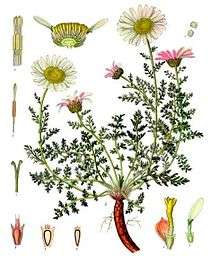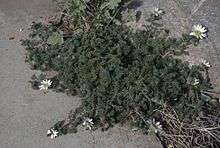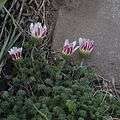Anacyclus pyrethrum
| Anacyclus pyrethrum | |
|---|---|
 | |
| Mount Atlas daisy | |
| Scientific classification | |
| Kingdom: | Plantae |
| Clade: | Angiosperms |
| Clade: | Eudicots |
| Clade: | Asterids |
| Order: | Asterales |
| Family: | Asteraceae |
| Genus: | Anacyclus |
| Species: | A. pyrethrum |
| Binomial name | |
| Anacyclus pyrethrum | |
| Synonyms | |
|
Anthemis pyrethrum L. | |
Anacyclus pyrethrum (pellitory, Spanish chamomile, or Mount Atlas daisy) is a perennial herb much like chamomile in habitat and appearance. It is in a different family (Asteraceae) from the plants known as pellitory-of-the-wall (Parietaria officinalis) and spreading pellitory (Parietaria judaica).
It is found in North Africa, elsewhere in the Mediterranean region, in the Himalayas, in North India, and in Arabian countries.[4]
Uses
It is popular as a food spice. It induces heat, tingling and redness when applied to the skin.
Although one might assume from the pyrethrum suffix that this plant may contain pyrethrins, it does not. The second part of the binomial name stems from the Ancient Greek name for the plant, πύρεθρον,[5] whereas the pyrethrins are named after Pyrethrum, used more recently for several plants of the genus Chrysanthemum, some of which do contain pyrethrins.[6]
Ayurveda (the ancient Indian medicine system) and Siddha (the medicine system from Tamil Nadu, a southern state of India) have uses for this plant root and it has been used for centuries as a medicine. It is called Akkal-Kara in Hindi, Akkal Kadha in Marathi, and Akkarakaaram (Tamil: அக்கரகாரம்). An oil is prepared by a method known as pit extraction (Tamil: குழி எண்ணெய்).
Extracts of Anacyclus pyrethrum have anabolic activity in mice and also increase testosterone in the animal model.[7][8]
Cultivation
A. pyrethrum var. depressus (sometimes considered a separate species, Anacyclus depressus), called mat daisy or Mount Atlas daisy, is grown as a spring-blooming, low-water ornamental. It produces mats of grey-green, ferny foliage and single daisy-like white flowers. It is suitable for growing in an alpine or rock garden. It has gained the Royal Horticultural Society’s Award of Garden Merit.[9]
Distribution
- Native
-
- Palearctic
- Northern Africa: Algeria, Morocco
- Southwestern Europe: Spain
References
- ↑ Rankou, H.; Ouhammou, A.; Taleb, M.; Manzanilla, V. & Martin, G. (2015). "Anacyclus pyrethrum". The IUCN Red List of Threatened Species (2015). Retrieved 23 January 2016.
- 1 2 Botanic Garden & Botanical Museum Berlin-Dahlem. "Details for: Anacyclus pyrethrum". Euro+Med PlantBase. Freie Universität Berlin. Retrieved 2008-06-16.
- 1 2 "Anthemis pyrethrum record n° 135636". African Plants Database. South African National Biodiversity Institute, the Conservatoire et Jardin botaniques de la Ville de Genève and Tela Botanica. Retrieved 2008-06-16.
- ↑ Brickell, Christopher, ed. (2008). The Royal Horticultural Society A-Z Encyclopedia of Garden Plants. United Kingdom: Dorling Kindersley. ISBN 9781405332965.
- ↑ A Greek-English Lexicon by Liddell/Scott/Jones (LSJ), entry πύρεθρον.
- ↑ http://users.skynet.be/bertram.zambiafoundation/Afbeeldingen/Literature_revue_Pyrethrum_root.pdf
- ↑ "Archived copy". Archived from the original on 2011-10-03. Retrieved 2011-07-31.
- ↑ Sharma, Vikas; Boonen, Jente; Spiegeleer, Bart De; Dixit, V. K. (January 2013). "Androgenic and Spermatogenic Activity of Alkylamide-Rich Ethanol Solution Extract of DC". Phytotherapy Research. 27 (1): 99–106. doi:10.1002/ptr.4697. PMID 22473789.
- ↑ "RHS Plantfinder - Anacyclus pyrethrum var. depressus". Royal Horticultural Society. Retrieved 12 January 2018.
- ↑ "Anacyclus pyrethrum". Germplasm Resources Information Network (GRIN). Agricultural Research Service (ARS), United States Department of Agriculture (USDA). Retrieved 2008-06-16.
External links
![]()
![]()
- UniProt. "Anacyclus pyrethrum". Retrieved 2008-06-16.
- M. Grieve (1931). "Pellitory". A Modern Herbal. © Copyright Protected 1995-2008 Botanical.com. Archived from the original on 9 July 2008. Retrieved 2008-06-16.
 Var. depressus
Var. depressus same plant, flower detail
same plant, flower detail Var. depressus, flowers closed
Var. depressus, flowers closed
